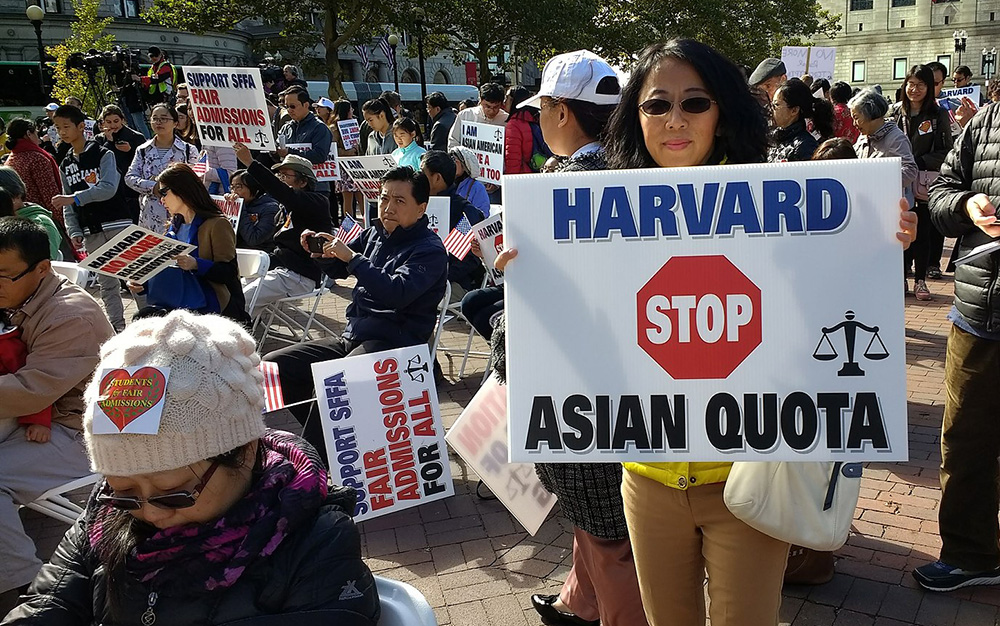The Past and Future of Affirmative Action in College Admissions
IPR talks with sociologist Anthony Chen about the Supreme Court and race-conscious admissions
Get all our news
What we'll see if the court takes affirmative action off the table altogether is which of the two sides is right. We'll get a clear answer in the next few years about what, if any, substitutes there are for race, and how good those substitutes are for different kinds of schools. ”
Anthony Chen
IPR sociologist

By the end of June, the Supreme Court will rule on the consideration of race in college admission decisions. Two cases allege that Harvard University and the University of North Carolina (UNC) discriminate against Asian American applicants.
Some colleges and universities use race as a factor in admissions, along with many other factors like athletics and activities, to create a diverse student body. The Students for Fair Admissions (SFFA), that brought the cases, argues that Harvard's practice violates Title VI of the Civil Rights Act of 1964 by discriminating against Asian American applicants, and claims that UNC violates the 14th Amendment's equal protection clause.
IPR spoke to sociologist Anthony Chen, an expert on affirmative action in higher education, about its history, the ongoing opposition to its use, and what might happen if, as many expect, the court strikes down race-conscious college admissions.
Chen is currently finishing his book with New York University's Lisa Stulberg that traces the history of affirmative action in college admissions.
This interview has been edited for length and clarity.
IPR: You and your co-author, Lisa Stulberg, have done extensive research into the origins of affirmative action, and you find the beginnings of it in the early 1960s. What did you learn?
Chen: What we learned is that it wasn't a creature of the 1970s, as many people have thought or assumed. It was a creature of the 1960s. And it was, in a way, a product of the Civil Rights Movement. It arose because deans, provosts, and presidents at certain selective institutions of higher education believed two things. Number one: They believed that diversity was an important factor in the quality of education that they provided to their students. They wanted to try to create a diverse student body for their students—and racial diversity was a special form of diversity that they wanted to provide. Second: They believed that it was incumbent on institutions of higher education to engage with a changing society by preparing the way for the world that would come after segregation. They wanted to make sure that educational opportunity was provided to minority applicants, and especially African American applicants, who could use a higher education to become fully integrated into American society.
IPR: Do you think that the administrators saw what they were doing as redressing the wrongs that had been created by discrimination?
Chen: There were really two rationales for affirmative action. One was the "diversity rationale." They wanted diversity, and race was a special form of diversity that became salient to them in 1963, especially as the Civil Rights Movement crested in its national significance. The other rationale is what we might call the "compensatory rationale." That is the idea that all kinds of institutions in the United States, not just higher education institutions, had a moral responsibility to act in a compensatory way to redress the racial inequality that has marked American society for centuries.
But the twist on that is that a lot of people think compensatory means making up for something bad that was done in the past. That was an element of their thinking. But in 1963 and 1964, there was a forward-looking dimension to their ideas. This was a moment when segregation was still not off the books. The men who were in charge of higher education institutions were thinking to themselves: "We're soon going to have a world one day where segregation is off the books." Although schools like Michigan, UCLA, and Cornell didn't really have Jim Crow segregation, they also didn't have very many African American students. So they thought they needed to do something more to create a world where racial equality was real, on the ground, and not just a promise in the air. They wanted to reimagine ways of assessing academic merit so that the next generation of Black applicants wouldn't be lost to racial inequality—so that capable Black applicants could get a higher education right away and begin to make their way in a society that was finally fully open to them.
IPR: Your research shows that there really was a concern about, or belief in, diversity as an educational value. Do the arguments made in SFAA v. Harvard (and SFAA v. UNC) to the Supreme Court affirm, contradict, or ignore the evidence you have uncovered about the origins of affirmative action?
Chen: There's a difference of opinion among the justices, not surprisingly, about what diversity is, and whether it's valuable and whether race can be legally and constitutionally considered to achieve it. I think that justices in the conservative majority are skeptical of all these things, and maybe the most skeptical of all the justices in the conservative majority is Clarence Thomas. Repeatedly, he has wondered out loud, "What is diversity?"
On the other hand, justices in the liberal minority don't really have a problem understanding what diversity is. They understand it, I think, in the way a lot of Americans understand it, which is diversity is just shorthand for Americans of different social backgrounds, and race is part of that and so are national origin, class, gender, and other factors.
Part of what's getting decided in this case is whose ideas about diversity are going to prevail. Justices in the conservative majority seem to think that diversity is a fig leaf or some kind of invention that was concocted ex post facto in the legal process to rationalize policies that were originally implemented for other reasons. Our research suggests that the diversity rationale originated with affirmative action from the start. Diversity was on the minds of the men who started affirmative action programs in 1963 and 1964. It wasn't something that their attorneys came up with in the 70s when they got scared that they might get sued.
Our research is not going to change anybody's mind about affirmative action necessarily, but it does, in our view, provide some important context for understanding where all this talk about diversity came from.
IPR: Why do you think the long-time opponents of affirmative action brought these cases using Asian Americans?
Chen: Starting in the 1990s, conservative legal organizations decided that they were tired of just writing amicus briefs in litigation around affirmative action, and they wanted to do something like what they thought was being done by the NAACP in the Brown v. Board of Education case. They wanted to do their part to initiate and shepherd original litigation through the courts. And so that's what they started to do [in Hopwood v. Texas, Grutter v. Bollinger, and Gratz v. Bollinger]. Then the ball was handed off to Ed Blum, who is a conservative legal activist, and he was a major force behind the Fisher v. University of Texas cases that came before the Supreme Court in the 2010s.
In all those cases, affirmative action was preserved, but its scope was limited: Schools were permitted to do less and less over time. A certain kind of program that operated in the 1990s, in which schools could take a giant stack of applications and mark them using a point system where race counted for a certain number of points, stopped being permissible with the Michigan cases, and the Fisher cases further clarified what was permissible and imposed even tighter bounds around schools. But affirmative action was still being permitted, under a system of holistic individualized review. This is what's on the table now in the Harvard and UNC cases.
Now all of the cases through Fisher involved a litigant who was White and, in some cases, White and Jewish. But the legal activists that were helping these plaintiffs bring their cases before the courts weren't quite getting the legal result they wanted. So I think that the strategic minds in the conservative movement felt like they needed to do something else. They noticed, I think, in both Clarence Thomas' and Sam Alito's concurrences and dissents in the Fisher cases, that at least two of the justices on the conservative side were extremely vexed about Asian Americans. As a result, I think it became clear to them that Asian Americans were, in a way, the next frontier in litigation, that they would make ideal litigants.
Another reason why is how Asian Americans fit into American political culture ideologically. Even though there's been a wave of anti-Asian hate in the last five or six years as a result of the COVID crisis, Asian Americans are also stereotyped as a model minority. And if you look at their average outcomes—education, employment, or income—they do come out extremely well compared to other racial minorities. As a result, they're often seen in America's racial landscape as deserving minorities who work hard and play by the rules. They are the "good minorities" and thus ideologically appealing for critics of affirmative action: Because if the admissions process isn't treating them right, then it's a hop, skip, and a jump to the idea that there must be something wrong with the admissions process. For that reason, I think it was inevitable that Asian Americans would eventually be brought into the picture, and that's exactly what happened.
It is worth highlighting that the plaintiff in this case is not actually a person. In all the other cases, there were actual live human beings with real grievances. But that's not the case with the two cases in front of the Supreme Court. Now the plaintiff is Students for Fair Admissions, a membership organization with Asian Americans members. But the plaintiff is not an Asian American individual, and I think that's quite informative and telling. I conclude, first, that they couldn't find anyone because they really would have done better if they had. The second conclusion I draw is that the litigation that we see now in front of the court is not the kind of bottom-up litigation that we saw in the 70s. It's really the culmination of a top-down process driven by legal activists.
IPR: If we assume the Supreme Court finds for the plaintiffs in these two cases (or even only one), of course the exact points of the opinion will be crucial. But what, in your opinion, are the best- and worst-case scenarios for college admissions if the court strikes down the current governing case law?
Chen: There's a range of possible outcomes. The most obvious outcome is that the court takes affirmative action off the books altogether, meaning that schools can no longer look at race in order to obtain some kind of educational value from diversity. If the court does that, then schools are going to have to turn to what are known in the field as race-neutral options, and there is a lot of argument about how well those can serve as an adequate substitute, and which particular type of policy is the best substitute. Can you use wealth or a lack of wealth as a proxy? Can you use income? Can you use the racial makeup of an applicant's ZIP code as a substitute? Can you use the racial makeup of the applicant's high school as a substitute? These are all possible ways to compensate for losing the ability to take race into account. In the litigation itself, the plaintiffs argue that there are some pretty good substitutes for the use of race, whereas the defendants say that there is no good substitute for race.
What we'll see if the court takes affirmative action off the table altogether is which of the two sides is right. We'll get a clear answer in the next few years about what, if any, substitutes there are for race, and how good those substitutes are for different kinds of schools.
It's not inconceivable that the court might preserve affirmative action, but it's probably unlikely. There are a couple of different ways it might "save" affirmative action. One, the Court could just say that the specific programs Harvard and UNC implemented were unconstitutional or illegal, and they've got to go back to the drawing board and come up with new programs that actually satisfy the requirements of the law and the Constitution. In this respect, the Court could say the program that UNC operated was not valid because the university doesn't really know whether its program delivered the educational benefits that it was supposed to. Two, the Court could say that race-neutral alternatives don't have to be perfect substitutes, just good enough to deliver most of the benefits that students are supposed to be getting. In either scenario, affirmative action is still possible, but it becomes really hard to do.
IPR: How do you measure the educational value of diversity?
Chen: The court might say to the defendants: "Well, you haven't done a good job of answering it yet, and the Constitution requires you to answer it clearly—and the answer must be, here's this specific educational benefit that kids at my school are demonstrably getting under affirmative action." And if you can't give that answer, then the courts are obligated, under the Constitution, to strike down whatever program you've been operating as unconstitutional. In some sense what the court might do is what it's been doing for the last three or four cases. It could say, we're not going to take affirmative action off the books, but the circumstances under which you can operate it are very stringent, more stringent than you thought, and you have not met them. That's a possible outcome.
Given the rulings we've seen from this particular court on a range of different issues, it's not likely that they're going to save affirmative action. But perhaps they will. We'll see what they say soon.
The following interview was conducted after the court’s decision.
IPR: What, if anything, in the decisions surprised you?
Chen: I will admit to feeling a little twinge of surprise. Like almost everyone else, I thought it unlikely that SCOTUS would “save” affirmative action. But then I learned why SCOTUS had declined to gut Section 2 of the Voting Rights Act in Allen v. Milligan, which it decided a couple of weeks before SFFA. Chief Justice Roberts’ majority opinion clearly said he wasn’t a fan of the way that Section 2 handled the issue of race, but he also said that a “faithful application of our precedents and a fair reading of the record” did not support the effort to “remake our jurisprudence anew.” This suggested to me that Ed Blum, SFFA and their allies maybe did not have what they needed to get the big result they wanted, given what the lower courts had found and how consistently they had interpreted precedent. But the high court chose a much less restrained path. The majority opinion scarcely touched on the findings and conclusions of the lower courts before invalidating pretty much all existing affirmative action programs in higher education—programs in which race had been considered flexibly as one of many factors in a system of holistic, individualized review.
IPR: Has the Supreme Court left any possibility of using race as a factor in college admissions?
Chen: It has left open the possibility, yes. The majority opinion says quite explicitly that “nothing in this opinion should be construed as prohibiting universities from considering an applicant’s discussion of how race affected his or her life, be it through discrimination, inspiration, or otherwise.” At the same time, universities are warned not to simply recreate the admission system that the high court is taking pains to invalidate. If applicants wish to discuss their race in their application essays, universities may consider such information only insofar as it is thought to shed light on personal qualities of the individual applicant that give them the “unique ability to contribute to the university.” This does not exactly clarify what specific practices are valid versus invalid. If admissions officers begin to rate application essays on the extent to which they speak to the individual applicant’s “unique ability to contribute to the university,” and it later comes out that Black applicants happen to get rated consistently higher on average than Asian American applicants, would such a system be regarded as unconstitutional? If admissions officers credit the application essay of a particular Latinx applicant because it reveals her grit in overcoming racial discrimination, and then the applicant is admitted, would such a practice really survive strict scrutiny as the majority now formulates it? After all, SFFA says plainly that “college admissions are zero sum.” The admission of one applicant necessarily entails the rejection of another. In this scenario, race would be getting used “as a negative.” Should it therefore fail strict scrutiny by the majority’s own standard?
IPR: What do you expect institutions of higher education to do going forward?
Chen: My sense is that many schools will turn to “race-neutral” alternatives to racial consideration; for instance, using income, wealth, or the racial composition of the applicant’s high school as a proxy for race. Many schools will probably redouble their recruitment efforts. But whether these steps will lead to similar levels of diversity as before is questionable. This was a topic that was exhaustively and expertly analyzed at trial, and both trial courts concluded that there were no “workable” race-neutral alternatives— meaning that there were no alternatives that would deliver the same level of racial diversity. How different schools fare under the new regime will probably depend on a lot of different variables. Will applicants change their application-sending behavior to various schools, and how? For instance, will even more Asian American applicants start applying to schools like Harvard, and will this change the test score and grade distribution of Asian American applicants there? Will fewer Black and Latinx applicants apply to schools like Harvard, changing their test score and grade distributions there? Are the best “race-neutral” alternatives also the costliest alternatives to implement, limiting the number of schools that can successfully use them? If there is a redistribution of Black and Latinx applicants away from more prestigious institutions and toward less prestigious institutions, how far down in the prestige hierarchy will one have to look to see similar levels of racial diversity as today? There is also a very real possibility that SFFA could have a chilling effect not just on admissions but scholarship and recruitment programs as well.
Universities are responding in a range of ways. While racial group membership per se cannot count, many institutions have indicated that they will consider applicants’ discussions of their racial background in a manner consistent with SFFA’s insistence that such discussions are used to shed light on applicants’ individual qualities, such as their grit or perseverance. It is also becoming clear that many institutions will continue to rely on place-based and race-neutral sources of information on applicants, as well as intensifying their outreach and recruitment efforts.
Anthony Chen is associate professor of sociology and of political science and an IPR fellow.
Photo credit: Whoisjohngalt
Published: June 15, 2023. Updated: December 14, 2023.


